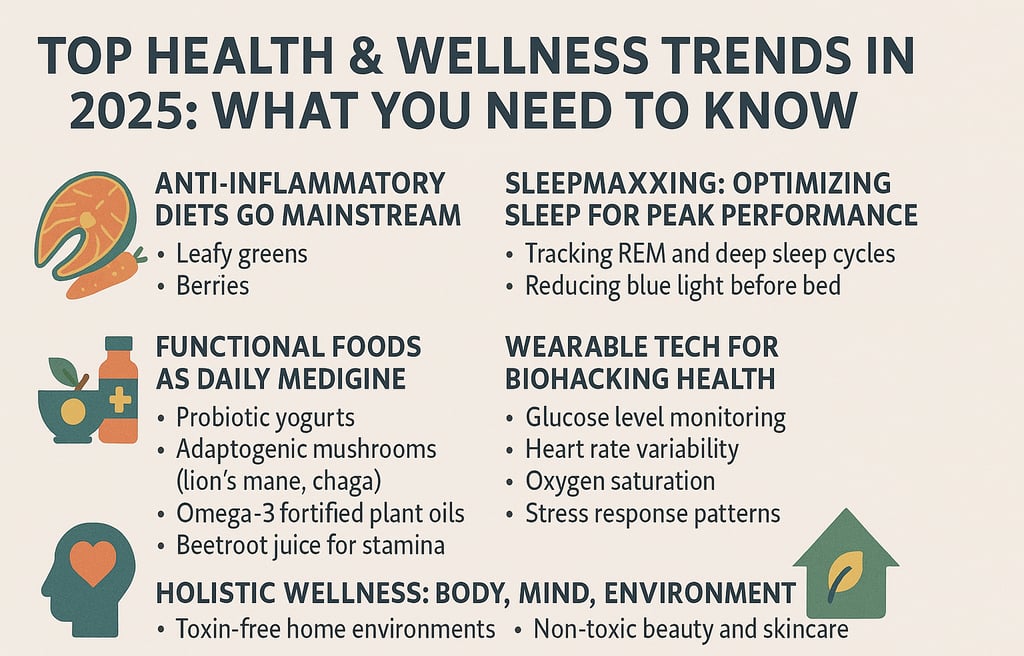Top Health and Wellness Trends 2025: Anti-Inflammatory, Sleepmaxxing & More
Saurodeep
5/23/20252 min read


Top Health & Wellness Trends in 2025: What You Need to Know
Staying healthy in 2025 means more than eating clean or working out—it’s about embracing new science, smarter habits, and sustainable self-care. As we move further into this decade, the health and wellness landscape continues to evolve rapidly, driven by technology, changing lifestyles, and a global focus on mental and emotional balance.
Let’s explore the top trends shaping wellness in 2025 that every individual and brand should be aware of.
1. Anti-Inflammatory Diets Go Mainstream
2025 marks a significant shift towards diets that actively reduce inflammation. With rising awareness of the links between chronic inflammation and diseases like arthritis, heart conditions, and even depression, people are choosing anti-inflammatory staples like:
Leafy greens
Berries
Fatty fish (like salmon)
Turmeric and ginger
Nutritionists are also seeing increased adoption of the Mediterranean and MIND diets, both of which are rooted in inflammation-fighting principles.
2. Functional Foods as Daily Medicine
Functional foods—those that offer benefits beyond basic nutrition—are gaining massive attention. Think:
Probiotic yoghurts
Adaptogenic mushrooms (like lion’s mane, chaga)
Omega-3 fortified plant oils
Beetroot juice for stamina
Consumers are turning to food as medicine, supporting immunity, digestion, cognitive performance, and energy levels through everyday meals.
3. Sleepmaxxing: Optimizing Sleep for Peak Performance
Forget just “getting 8 hours.” In 2025, it’s about sleep quality—a trend called sleepmaxxing. From sleep trackers to melatonin diffusers and AI-powered smart mattresses, the focus is now on:
Tracking REM and deep sleep cycles
Reducing blue light exposure before bed
Implementing personalized sleep plans
This shift is being driven by both fitness communities and corporate wellness programs.
4. Mental Wellness as a Core Pillar
Mental health is no longer an afterthought—it’s central to any health conversation. In 2025
Microtherapy sessions and mental health check-ins are standard at workplaces.
Meditation apps powered by AI create personalized wellness journeys.
Journaling, breathwork, and digital detoxes are trending as part of daily routines.
There’s a sharp move from reactive therapy to preventive mental wellness, making self-awareness and mindfulness mainstream.
5. Wearable Tech for Biohacking Health
Smart wearables are evolving beyond fitness tracking. New-generation devices now track:
Glucose levels (non-invasively)
Heart rate variability
Oxygen saturation
Stress response patterns
With real-time feedback and AI integrations, users can optimize lifestyle habits minute-by-minute. Biohacking, once niche, is becoming accessible to the everyday consumer.
6. Holistic Wellness: Body, Mind, Environment
2025 introduces the “ecosystem of wellness.” Consumers now care about:
Toxin-free home environments
Indoor air purifiers
Non-toxic beauty and skincare products
Stress-reducing interior design (dopamine decor)
It’s no longer just you—it’s your entire living environment that defines well-being.
7. Preventive Care Over Reactive Treatment
Preventive care is overtaking symptom-focused treatment. People are actively:
Doing annual bloodwork and genetic screening
Using health subscription models for continuous monitoring
Accessing AI health assistants for early risk detection
This trend aligns with a global push to reduce long-term healthcare costs and promote proactive self-care.
Conclusion
Health in 2025 is about empowered choices—integrating science, tech, and mindfulness to build a balanced lifestyle. From what we eat to how we sleep and interact with our environment, wellness is becoming more personalized and preventive. Whether you’re an individual or a business in the health space, aligning with these trends is no longer optional—it’s essential.
About One Solution
Quick Links
Contact Info
One Solution — Your trusted partner for financial success.
📍 F17, Grand Plaza, Paltan Bazar
Guwahati, Kamrup (M), Assam
India, Pin: 781008
📞 9650072280
© 2025 One Solution. All Rights Reserved.
